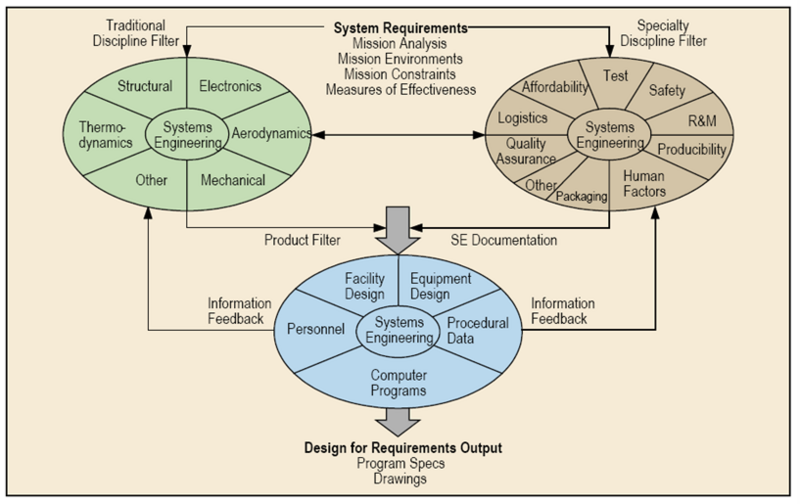Systems Engineering and Quality Attributes
Lead Author: Dave Olwell, Contributing Authors: Richard Turner, Dick Fairley, Scott Jackson, Alice Squires
Every system has a set of properties that are largely a function of the system as a whole rather than just its constituent parts; e.g., security, reliability, cost, and resilience. This KA describes the engineering disciplines that enable the realization of those properties. Collectively, these disciplines are referred to as Specialty engineering.
Some consider specialty engineering to be a sub-discipline of SE itself; e.g. they consider security engineering, safety engineering, resilience engineering, etc. to be part of SE. Others consider them to be stand-alone disciplines in their own right. Either way, their mastery is important to a system engineer. Moreover, they are usually interdependent; e.g. increasing system reliability often requires using more expensive parts and adding redundant components. Hence, higher reliability often means higher cost to deliver a system – another system property. However, higher reliability might mean lower maintenance cost – another system property. A systems engineer typically makes many decisions and takes many actions with regard to system properties; e.g., specifying which properties are important for a particular system, stating how those properties will be measured, trading off conflicting properties, and verifying that a system has the specified properties. This Knowledge Area includes topical articles on several specialty engineering disciplines such as Reliability, Availability, and Maintainability. .
Topics
Each part of the SEBoK is divided into knowledge areas (KAs), which are groupings of information with a related theme. The KAs, in turn, are divided into topics. This KA contains the following topics:
- Reliability, Availability, and Maintainability
- Human Systems Integration
- Security Engineering
- Electromagnetic Interference/Electromagnetic Compatibility
- System Resilience
- Manufacturability and Producibility
- Affordability
- Environmental Engineering
- Logistics Engineering
Specialty Requirements
The systems engineering team must ensure that specialty requirements are properly reviewed with regard to their impact on life cycle costs, development schedule, technical performance, and operational utility. For example, security requirements can impact operator workstations, electromagnetic interference requirements can impact the signal in the interfaces between subsystems, and mass-volume requirements may preclude the use of certain materials to reduce subsystem weight.
Engineering specialists audit the evolving design and resulting configuration items to ensure that the overall system performance also satisfies the specialty requirements. Including appropriate specialty engineers within each systems engineering team assures that all system requirements are identified and balanced throughout the development cycle.
Integration of Specialty Engineering
Integration of engineering specialties into a project or program is, or should be, a major objective of systems engineering management. (Endler 2016) With properly implemented procedures, the rigor of the systems engineering process ensures participation of the specialty disciplines at key points in the technical decision-making process. Special emphasis on integration is mandatory because a given design could in fact be accomplished without consideration of these specialty disciplines, leading to the possibility of system ineffectiveness or failure when an unexamined situation occurs in the operational environment.
For example, human factors considerations can contribute to reduced workloads and therefore lower error rates by operators in aircraft cockpits, at air-traffic consoles, or nuclear reactor stations. Similarly, mean-time-to-repair features can significantly increase overall system availability in challenging physical environments, such as mid-ocean or outer space. Specialty engineering requirements are often manifest as constraints on the overall system design space. The role of system engineering is to balance these constraints with other functionality in order to harmonize total system performance. The end goal is to produce a system that provides utility and effectiveness to the customer at an affordable price.
As depicted in Figure 1, systems engineering plays a leadership role in integrating traditional disciplines, specialty disciplines, and unique system product demands to define the system design. Relationships for this integration process are represented as interactions among three filters.
The first filter is a conceptual analysis that leverages traditional design consideration (structural, electronics, aerodynamics, mechanical, thermodynamics, etc.). The second filter evaluates the conceptual approach using specialty disciplines, such as safety, affordability, quality assurance, human factors, reliability and maintainability, producibility, packaging, test, logistics, and others, to further requirements development. Design alternatives that pass through these two processes go through a third filter that incorporates facility design, equipment design, procedural data, computer programs, and personnel to develop the final requirements for design selection and further detailed development.
References
Works Cited
D. Endler. 2016. "Integration of Specialty Engineering Activities". Proceedings of the 26th Annual International Council on Systems Engineering (INCOSE) International Symposium, July 18-21, 2016, Edinburgh, Scotland, UK.
USAF. 2000. Guidelines for Successful Acquisition and Management of Software-Intensive Systems: Weapon Systems Command and Control Systems Management Information Systems, version 3.0. Hill AFB: Department of the Air Force Software Technology Support Center. May 2000. Accessed on September 11, 2011. Available at http://www.stsc.hill.af.mil/resources/tech%5Fdocs/.
Primary References
USAF. 2000. Guidelines for Successful Acquisition and Management of Software-Intensive Systems: Weapon Systems Command and Control Systems Management Information Systems, version 3.0. Hill AFB: Department of the Air Force Software Technology Support Center. May 2000. Accessed on September 11, 2011. Available at http://www.stsc.hill.af.mil/resources/tech%5Fdocs/.
Additional References
None.
